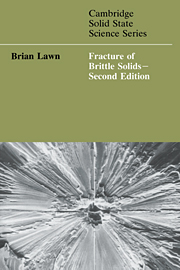Book contents
- Frontmatter
- Contents
- Preface
- Glossary of symbols and abbreviations
- 1 The Griffith concept
- 2 Continuum aspects of crack propagation I: linear elastic crack-tip field
- 3 Continuum aspects of crack propagation II: nonlinear crack-tip field
- 4 Unstable crack propagation: dynamic fracture
- 5 Chemical processes in crack propagation: kinetic fracture
- 6 Atomic aspects of fracture
- 7 Microstructure and toughness
- 8 Indentation fracture
- 9 Crack initiation: flaws
- 10 Strength and reliability
- References and reading list
- Index
3 - Continuum aspects of crack propagation II: nonlinear crack-tip field
Published online by Cambridge University Press: 14 January 2010
- Frontmatter
- Contents
- Preface
- Glossary of symbols and abbreviations
- 1 The Griffith concept
- 2 Continuum aspects of crack propagation I: linear elastic crack-tip field
- 3 Continuum aspects of crack propagation II: nonlinear crack-tip field
- 4 Unstable crack propagation: dynamic fracture
- 5 Chemical processes in crack propagation: kinetic fracture
- 6 Atomic aspects of fracture
- 7 Microstructure and toughness
- 8 Indentation fracture
- 9 Crack initiation: flaws
- 10 Strength and reliability
- References and reading list
- Index
Summary
Irwin's generalisation of the Griffith concept, as outlined in the previous chapter, provides us with a powerful tool for handling the mechanics of fracture. In particular, by balancing mechanical energy released against surface energy gained we have a thermodynamically sound criterion for predicting when an ideally brittle crack will extend. But the Irwin mechanics tell us nothing as to how that crack extends. Whenever we have had occasion to refer to events at the tip the description has proved totally inadequate. The singularities in the continuum linear elastic solutions simply cannot be reconciled with any physically realistic local rupture process. Assuming the first law of thermodynamics to be beyond question, it is clear that some vital element is missing in the fracture mechanics: it is not the Griffith energy balance that is at issue here, but rather the mechanism by which this balance is effected.
In this chapter we question the adequacy of the linear continuum representation of matter. Real solids tend to a maximum in the intrinsic stress–strain characteristic. This is true even of perfectly brittle solids which fracture by bond rupture. In addition, crack growth can be accompanied by deformation processes in the near-tip field. Such deformation can be highly dissipative. If there is to be any proper basis for understanding the behaviour of ‘tough’ ceramics and other brittle materials for structural applications we must include provision for nonlinear and irreversible elements in the equilibrium fracture mechanics.
- Type
- Chapter
- Information
- Fracture of Brittle Solids , pp. 51 - 85Publisher: Cambridge University PressPrint publication year: 1993
- 2
- Cited by



